The Microbial Coagulants Market is estimated to be valued at USD 240.0 million in 2025 and is projected to reach USD 335.3 million by 2035, registering a compound annual growth rate (CAGR) of 3.4% over the forecast period.
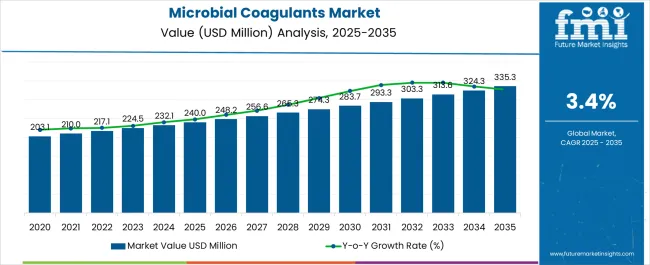
| Metric | Value |
|---|---|
| Microbial Coagulants Market Estimated Value in (2025 E) | USD 240.0 million |
| Microbial Coagulants Market Forecast Value in (2035 F) | USD 335.3 million |
| Forecast CAGR (2025 to 2035) | 3.4% |
The Microbial Coagulants market is experiencing steady growth, driven by increasing demand for sustainable and safe alternatives to animal-derived coagulants in the food processing industry. In particular, the rising consumption of cheese and other dairy products has created strong demand for efficient microbial coagulants that offer consistent performance and reduce dependency on traditional rennet.
Growth is also being influenced by increasing regulatory focus on food safety and the adoption of vegetarian-friendly production methods, which favor microbial sources. The market is further supported by advancements in fermentation technology and strain optimization, enabling higher yield and consistent enzymatic activity.
Companies are investing in scalable microbial fermentation processes to meet growing commercial demand, while cost optimization and stability of microbial preparations contribute to their adoption As global dairy production and processed cheese consumption continue to rise, the microbial coagulants market is expected to maintain its upward trajectory, offering opportunities for producers to expand their portfolio and penetrate emerging markets.
The microbial coagulants market is segmented by form, source, end use, distribution, and geographic regions. By form, microbial coagulants market is divided into Dry and Liquid. In terms of source, microbial coagulants market is classified into Rhizomucor Miehei, Cryphonectria Parasitica, and Mucor Pusillus. Based on end use, microbial coagulants market is segmented into Cheese, Ice Cream & Dessert, Yogurt, and Whey. By distribution, microbial coagulants market is segmented into Wholesale, Online Retailers, Supermarkets, and Specialty Stores. Regionally, the microbial coagulants industry is classified into North America, Latin America, Western Europe, Eastern Europe, Balkan & Baltic Countries, Russia & Belarus, Central Asia, East Asia, South Asia & Pacific, and the Middle East & Africa.
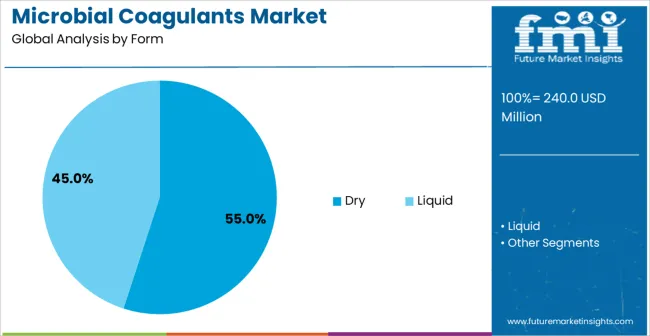
The Dry form segment is projected to account for 55.00% of the Microbial Coagulants market revenue in 2025, making it the leading form type. This dominance has been influenced by the advantages associated with dry formulations, including longer shelf life, ease of storage, and simplified transportation logistics. Dry microbial coagulants allow manufacturers to maintain enzymatic activity over extended periods without requiring refrigeration, reducing operational costs.
The flexibility of dry forms in industrial applications, including precise dosing and controlled dissolution, has facilitated widespread adoption in large-scale dairy processing. Additionally, the scalability of dry microbial coagulant production aligns with increasing cheese manufacturing volumes, ensuring consistent coagulation performance across batches.
The format also supports integration with automated production lines, contributing to operational efficiency and minimizing process variability These factors collectively underpin the segment's leading position in the market and indicate strong growth potential as demand for high-quality microbial coagulants continues to rise.
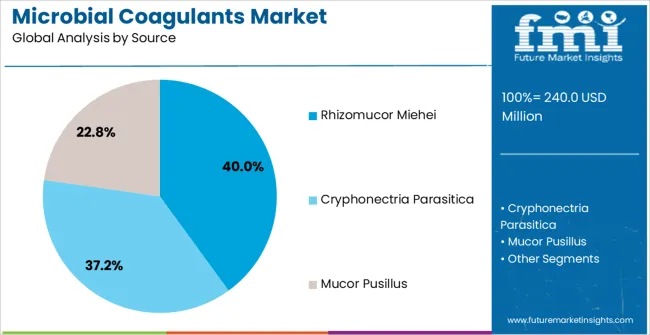
The Rhizomucor Miehei source segment is estimated to capture 40.00% of total revenue in 2025, making it the largest contributor among microbial strains. This predominance is being driven by its efficient proteolytic activity and strong clotting properties, which are particularly suitable for cheese production.
The strain is favored for its ability to provide consistent curd firmness, flavor development, and compatibility with a variety of cheese types. Its fermentation process can be easily scaled to meet industrial demands, allowing manufacturers to achieve high yields without compromising quality.
The preference for Rhizomucor Miehei is also reinforced by its widespread acceptance in commercial and regulatory frameworks, making it a reliable choice for both established and emerging cheese producers With increasing global cheese consumption and rising interest in vegetarian-friendly ingredients, the Rhizomucor Miehei source segment is expected to maintain its leadership and continue driving overall microbial coagulant market growth.
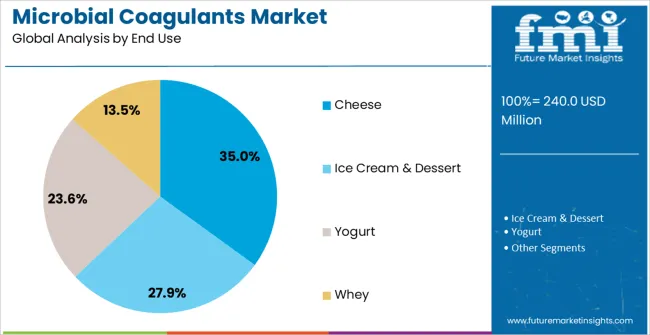
The Cheese end-use segment is anticipated to hold 35.00% of the Microbial Coagulants market revenue in 2025, positioning it as the leading application. This segment's growth has been fueled by expanding cheese production worldwide and increasing consumer preference for processed and specialty cheeses.
Microbial coagulants offer precise control over coagulation time, curd quality, and flavor development, making them ideal for industrial-scale cheese manufacturing. The demand is further supported by the need for consistent quality across large production volumes and by the adoption of vegetarian-friendly ingredients to meet regulatory and consumer expectations.
Advances in microbial enzyme technology have also improved performance, ensuring that curd yield and texture meet industrial standards As dairy producers continue to prioritize efficiency, consistency, and sustainability, the cheese end-use segment is expected to remain a dominant driver for the microbial coagulants market, with continued opportunities for expansion in both mature and emerging markets.
Microbial coagulants are enzymes used in the cheese-making process to coagulate milk. These microorganisms include bacteria, fungus, and yeast. These enzymes are frequently referred to as rennet replacements or rennet. Casein, a milk protein, is broken down by microbial coagulants, causing curds to form. The texture, flavor, and ripening period of the cheese produced can all be impacted by the kind of microbial coagulant utilized. Microbial coagulants, an alternative to conventional animal rennet, are typically regarded as safe and effective. They are commonly employed in the dairy sector to increase cheese yields and uniformity as well as in the manufacturing of vegetarian and vegan cheeses.
The Rhizomucor miehei, a fermentation-produced chymosin from either fungi or yeast, is the typical source of microbial coagulants. They are an organic, non-GMO, non-animal product that has received certification for both Kosher and halal by reputable certifying organizations across many different areas and nations. Rhizomucor miehei or pusillus, which are mostly utilized in the food sector for the manufacturing of cheese, are fermented under regulated conditions to create the microbial coagulants.
In our new study, ESOMAR-certified market research and consulting firm Future Market Insights (FMI) offers insights into key factors driving demand for Microbial Coagulants.
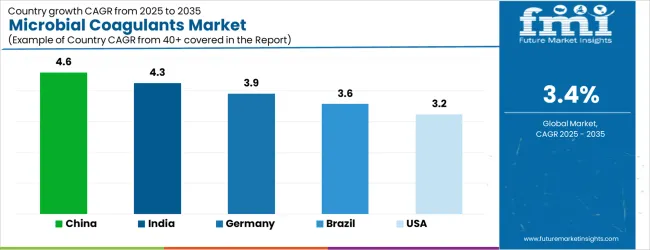
| Country | CAGR |
|---|---|
| China | 4.6% |
| India | 4.3% |
| Germany | 3.9% |
| Brazil | 3.6% |
| USA | 3.2% |
| UK | 2.9% |
| Japan | 2.6% |
The Microbial Coagulants Market is expected to register a CAGR of 3.4% during the forecast period, exhibiting varied country level momentum. China leads with the highest CAGR of 4.6%, followed by India at 4.3%. Developed markets such as Germany, France, and the UK continue to expand steadily, while the USA is likely to grow at consistent rates. Japan posts the lowest CAGR at 2.6%, yet still underscores a broadly positive trajectory for the global Microbial Coagulants Market. In 2024, Germany held a dominant revenue in the Western Europe market and is expected to grow with a CAGR of 3.9%. The USA Microbial Coagulants Market is estimated to be valued at USD 89.0 million in 2025 and is anticipated to reach a valuation of USD 89.0 million by 2035. Sales are projected to rise at a CAGR of 0.0% over the forecast period between 2025 and 2035. While Japan and South Korea markets are estimated to be valued at USD 12.2 million and USD 7.6 million respectively in 2025.
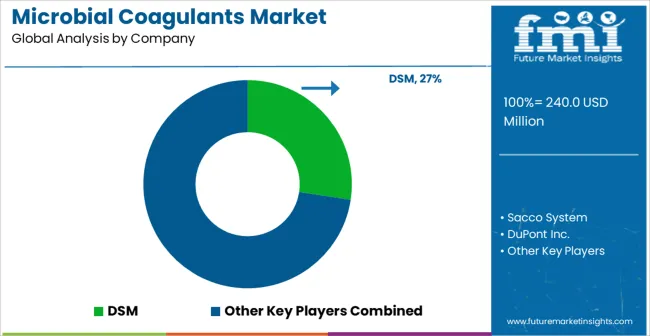
| Item | Value |
|---|---|
| Quantitative Units | USD 240.0 Million |
| Form | Dry and Liquid |
| Source | Rhizomucor Miehei, Cryphonectria Parasitica, and Mucor Pusillus |
| End Use | Cheese, Ice Cream & Dessert, Yogurt, and Whey |
| Distribution | Wholesale, Online Retailers, Supermarkets, and Specialty Stores |
| Regions Covered | North America, Europe, Asia-Pacific, Latin America, Middle East & Africa |
| Country Covered | United States, Canada, Germany, France, United Kingdom, China, Japan, India, Brazil, South Africa |
| Key Companies Profiled | DSM, Sacco System, DuPont Inc., Chr. Hansen, CSK Food Enrichment, Meito Sangyo Co., Ltd., BASF SE, SNF Group, Solenis, Kemira, and Mitsubishi Chemical Holding Company |
The global microbial coagulants market is estimated to be valued at USD 240.0 million in 2025.
The market size for the microbial coagulants market is projected to reach USD 335.3 million by 2035.
The microbial coagulants market is expected to grow at a 3.4% CAGR between 2025 and 2035.
The key product types in microbial coagulants market are dry and liquid.
In terms of source, rhizomucor miehei segment to command 40.0% share in the microbial coagulants market in 2025.






Our Research Products

The "Full Research Suite" delivers actionable market intel, deep dives on markets or technologies, so clients act faster, cut risk, and unlock growth.

The Leaderboard benchmarks and ranks top vendors, classifying them as Established Leaders, Leading Challengers, or Disruptors & Challengers.

Locates where complements amplify value and substitutes erode it, forecasting net impact by horizon

We deliver granular, decision-grade intel: market sizing, 5-year forecasts, pricing, adoption, usage, revenue, and operational KPIs—plus competitor tracking, regulation, and value chains—across 60 countries broadly.

Spot the shifts before they hit your P&L. We track inflection points, adoption curves, pricing moves, and ecosystem plays to show where demand is heading, why it is changing, and what to do next across high-growth markets and disruptive tech

Real-time reads of user behavior. We track shifting priorities, perceptions of today’s and next-gen services, and provider experience, then pace how fast tech moves from trial to adoption, blending buyer, consumer, and channel inputs with social signals (#WhySwitch, #UX).

Partner with our analyst team to build a custom report designed around your business priorities. From analysing market trends to assessing competitors or crafting bespoke datasets, we tailor insights to your needs.
Supplier Intelligence
Discovery & Profiling
Capacity & Footprint
Performance & Risk
Compliance & Governance
Commercial Readiness
Who Supplies Whom
Scorecards & Shortlists
Playbooks & Docs
Category Intelligence
Definition & Scope
Demand & Use Cases
Cost Drivers
Market Structure
Supply Chain Map
Trade & Policy
Operating Norms
Deliverables
Buyer Intelligence
Account Basics
Spend & Scope
Procurement Model
Vendor Requirements
Terms & Policies
Entry Strategy
Pain Points & Triggers
Outputs
Pricing Analysis
Benchmarks
Trends
Should-Cost
Indexation
Landed Cost
Commercial Terms
Deliverables
Brand Analysis
Positioning & Value Prop
Share & Presence
Customer Evidence
Go-to-Market
Digital & Reputation
Compliance & Trust
KPIs & Gaps
Outputs
Full Research Suite comprises of:
Market outlook & trends analysis
Interviews & case studies
Strategic recommendations
Vendor profiles & capabilities analysis
5-year forecasts
8 regions and 60+ country-level data splits
Market segment data splits
12 months of continuous data updates
DELIVERED AS:
PDF EXCEL ONLINE
Microbial Growth Monitoring System Market Size and Share Forecast Outlook 2025 to 2035
Microbial Polyketides Market Analysis - Size, Share, and Forecast Outlook 2025 to 2035
Microbial Nucleotides Market Analysis - Size, Share, and Forecast Outlook 2025 to 2035
Microbial Fermentation Technology Market Size and Share Forecast Outlook 2025 to 2035
Microbial Gene Editing Services Market Size and Share Forecast Outlook 2025 to 2035
Microbial Lipids Size and Share Forecast Outlook 2025 to 2035
Microbial Therapeutic Products Market Size and Share Forecast Outlook 2025 to 2035
Microbial Lipase Market - Size, Share, and Forecast Outlook 2025 to 2035
Analysis and Growth Projections for Microbial Seed Treatment Business
Analysis and Growth Projections for Microbial Food Culture Business
Microbial Protein Used in Feed Market Analysis by Application, Source, and Region Through 2035
Microbial Identification Market Report – Growth & Forecast 2025-2035
Microbial Feed Additives Market – Growth, Probiotics & Livestock Nutrition
Microbial Bioreactors Market
Microbial Rennet Market
Antimicrobial HVAC Coating Market Size and Share Forecast Outlook 2025 to 2035
Antimicrobial Hospital Textile Market Forecast Outlook 2025 to 2035
Antimicrobial Glass Powder Market Forecast and Outlook 2025 to 2035
Antimicrobial Cap Fitters Market Size and Share Forecast Outlook 2025 to 2035
Antimicrobial Powder Coating Market Size and Share Forecast Outlook 2025 to 2035

Thank you!
You will receive an email from our Business Development Manager. Please be sure to check your SPAM/JUNK folder too.
Chat With
MaRIA